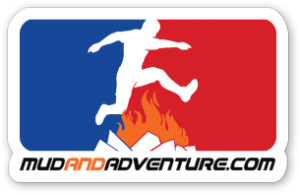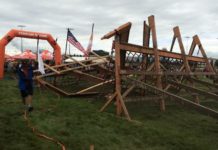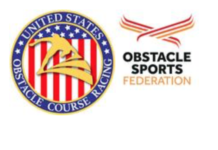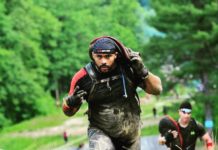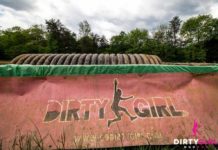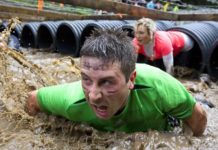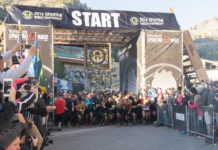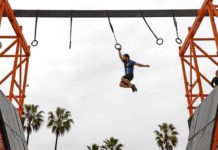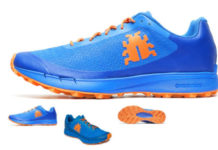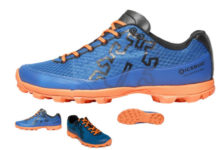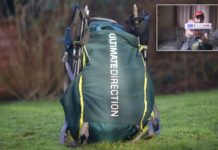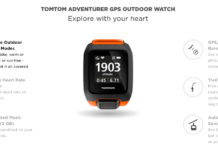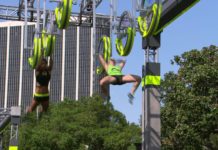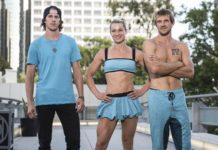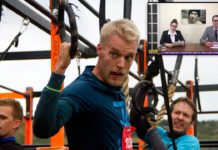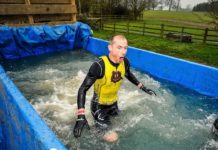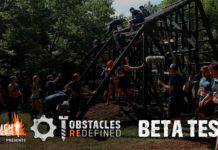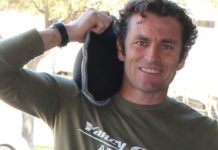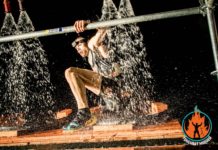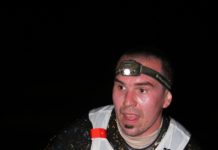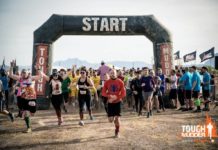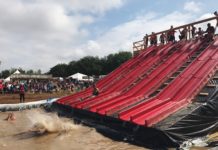Worlds Toughest Mudder is the culminating event of the Tough Mudder race series. A standard TM is 8-10 miles of mud, obstacles and water. Worlds Toughest Mudder (WTM) is an entirely different animal, and involves a standard Tough Mudder course, and a 24 hour time window. The goal? Complete as many laps as possible in the 24 hour time frame. This is going to be fun….
The Background
 I had been here before. In 2012, I took on Worlds Toughest Mudder as a relative newbie, who thought he was much tougher than he ended up being. I showed up with only two OCR’s under my belt, a 2mm shortie suit and the idea that not finishing…really wasn’t an idea at all, more like an impossibility. Fast forward to 11pm that night, 30 miles into the race and more than half the allotted time still left on the clock, I crawled away, a defeated, hypothermic, crying mess. For the first time in my athletic career, I had quit something, I DNF’d, and in the process, changed the course of my life completely. As my friends and family carried me away from Raceway Park that night, I realized my life had changed, and more importantly….I would be back.
I had been here before. In 2012, I took on Worlds Toughest Mudder as a relative newbie, who thought he was much tougher than he ended up being. I showed up with only two OCR’s under my belt, a 2mm shortie suit and the idea that not finishing…really wasn’t an idea at all, more like an impossibility. Fast forward to 11pm that night, 30 miles into the race and more than half the allotted time still left on the clock, I crawled away, a defeated, hypothermic, crying mess. For the first time in my athletic career, I had quit something, I DNF’d, and in the process, changed the course of my life completely. As my friends and family carried me away from Raceway Park that night, I realized my life had changed, and more importantly….I would be back.
The Build Up
2013 was my first year racing as a “professional” obstacle course and adventure racer. Over the course of the year, I ran more Spartan Races than I can count, every trail race I could find, marathons, ultra-marathons and GoRuck Challenges galore. I was lucky enough to receive sponsorships through some incredible companies: Team Mud and Adventure, Pearl Izumi and Reload Fitness. I finished top 25 in the majority of Spartan Races I competed in, and took on and finished the Ultra Beast in Vermont. Finishing the UB was at the time, my crowning achievement in my racing career. Crossing the finish line in Vermont, I felt a lot of emotions. I was proud that I was one of less than 110 people to finish the race. I was ridiculously happy to be done. I was hungry….really really hungry. But most of all, I felt angry. I felt angry that I had been able to tackle such a monster of a race less than a year removed from my defeat in NJ. My mind immediately shifted to WTM, and as I sat on the floor by the bag check recovering and letting my mind and body return to normal, a fire ignited inside of me, all I could see was orange, the TM orange…WTM…I was ready.
After the UB, I trained hard and trained smart. The mileage was there, I had been logging 100+ mile weeks leading up to VT, and I knew I had to be careful to avoid injury. So..in order to be smart and avoid said injury, I decided to run the Chicago Marathon with zero prep, less than three weeks before WTM…what could go wrong!? After all, I had not ran on a paved surface for more than 5 miles in..oh I don’t know, 2 years? But hey, I’m tough as nails and I got this!
26.2 miles later, and I was the happy recipient of a Chicago Marathon finishers medal, and a sever case of Iliotibial Band Syndrom (ITBS)/a slight lateral meniscus tear. At first, the pain was crippling. In the days and weeks after the marathon, I stumbled through 2-3 mile runs filled with constant pain, more “F**K YOU KNEE”‘s than I can count, and a growing sense of “what the hell did I do” settling in. With WTM less than a week away, I had not logged a run longer than 3 miles in over a month, my knee pain was fairly constant, and for a fleeting moment, I considered not going to New Jersey.
After slapping myself in the face, I realized not going was not an option. If I had to walk 24 hours straight, I would. If I could not walk, I was ready to crawl, and if I couldn’t crawl I’d roll. 2012 WTm had haunted my dreams too many nights for this to not happen. I needed closure, I needed to be at this war.
Gear/nutrition/support
I traveled to New Jersey on Thursday, pushing any sense of doubt as far into the back of my mind as I could. I had collected what I felt was all the gear I needed, had a crew member that knew me better than anyone (my girlfriend), and knew I had my two best friends coming to watch (and more importantly to them drink) the entire 24 hours. My gear list looked like this:
-2mm shortie suit
-5/3 hooded full suit
-2 pairs of neoprene 3mm gloves
-3 head lamps, 3 emergency strobes
-running belt
-Under Armor base layers
-Swiss outershell (both upper and lower)
-5 pairs of standard under armor socks
Salomon Speed Cross 3’s and a back up pair of Peak II Pearl Izumi trail shoes
The forecast was looking much warmer than 2012, and so I knew my shortie was going to be huge for me. I had endured 30 miles in the sub freezing temperatures the year before, and was confident I could get through much of the daytime this year with it before switching to my full suit at night. My nutrition was fairly simple as well. I prepackaged 15 bags, one for each lap I could potentially complete (let’s be honest, I wasn’t going to knock out 100 miles!). In each, I had a small container of peaches, raisins, turkey jerky, granola bars, M&M’s, almonds and Cliff Bloks. At the end of each lap, I would grab a bag and keep moving, eating while I walked the first 1/8th of a lap. I wanted to constantly be racking up mileage….stopping at WTM is a death sentence. Overall my nutrition was perfect for me. I was never overly hungry, I drank an electrolyte mix every lap, and never pitted more than 15 minutes (except for once when I rinsed off in the shower). A typical pit was 5-10 minutes, and then it was on to the next lap. We arrived Friday night, set up the pit, headed back to the hotel and got some sleep, ready for hell the next day.
Race Day
Mother Nature was kind, and although slightly dreary, we arrived to Raceway Park under cloudy skies and 45 degree weather. As I finished setting up my pit, I made the decision right away to wear my shortie the first lap. This year, the course was 5 miles long with 22 obstacles. The first lap was a sprint, designed to spread out the racers, 5 miles, no obstacles, winner gets a cool bib and the others get a view of the course. Many racers ran this first lap in shorts and a shirt, then switched into a shortie after lap 1. I didn’t see a reason to waste time, and ran in my shortie, sticking to the middle of the pack, running the first 5 in 50 minutes flat. The course looked great, and it was apparent that there were plenty of water obstacles. My wetsuit would be needed in the later hours, and I knew this course was going to break more people than it was given credit to do. I pitted for less than minutes, hammered down a bottle of water and got back on the course…bring on the obstacles.
The course consisted of 22 obstacles, some of which had penalty options if you could not complete them. These penalties varied from tire flips to log carries. After leaving the pit. we journeyed around half a mile down the drag strip and did a U-turn into the mud mile. This is a series of chest deep mud pits, that after jumping into, you were forced to claw your way up a dirt wall, then drop back into another mud pit. This repeated itself around 8 times, and the water was very cold from the start. I’m pretty sure it warmed up as the day went on simply due to the amount of urine and other bodily fluids racers let go while in it.
A quick jog after the mud mile and we were at the A-frame. This was a fairly simple obstacle, with two slanted walls set up like this /\ with ropes on either side. The frame was roughly 12-15 feet tall, and was muddy from the start. I ended up hating this in the late hours. Clawing your way up the rope was not too difficult, but the descent was brutally slippery, and with sore legs was downright awful. I took the penalty obstacle once on this, which was a 100 yard log carry. On my 2nd lap, this was when the knee pain started. I gimped away from the A-frame less than 10 miles into my race, already in excruciating amounts of pain, this was going to be a long day.
After the A-Frame, we took a stroll through the dirt bike track, climbing mud mounts and weaving our way to a low crawl. We hit the barbed wire and mud hard, and had around a 15-20 yard roll/crawl. This was actually one of the lower crawls I’ve ever gone through in an OCR, and being a bigger guy, was having a hard time rolling without hitting the barbed wire. After the crawl, we ran a few more hills and came to the blades of glory, essentially a series of backwards slanted walls looking like this \ \ \. These had no foot or hand holds, and as the night progressed got a little tricky. The penalty obstacle here was a 100 yard log carry, which I did once on a particularly rough lap. At this point my entire leg was in pain, I could barely lift my left leg, I had tears in my eyes every step, this was going to be a long day.
After gimping away from the walls, we came upon the wooden spider. I disliked everything about this obstacle…it was annoying, hard to do at night, not fun and exhausting. You had a long crawl through a drainage pipe, that led you to a small space between two wood walls, which you had to then monkey up and climb out the top and then climb down a cargo net on the other side.
I finished this and moved on to the next stretch, which consisted of a little run. I tried to get moving to loosen up the leg, but ended up doing a very awkward frankenstein-like run. I would jog 10 yards, walk 25. The knee was excruciating and I was questioning how I was going to stand this pain through the entire day.
Next we came to something straight from American Ninja Warrior…QUAD STEPS! I had never done these before and they looked pretty fun. Basically you got a running start, and jumped laterally from one slanted wooden platform to another, while trying not to slip into the water/mud pit that was dug out in between. Although I never failed this obstacle, it really put a hurting on my already injured knee. Every impact on my left leg felt like someone had hit me with a hammer. I actually never saw anyone fail this obstacle, and although it was pretty muddy by the end of the 24 hours, it never was much of a concern in my mind.
The next three obstacles came in quick succession. We had a tire carry that last around 100 yards, twinkle toes (a balance beam over water) and “just the tip”. I was concerned with just the tip going into the race, having never experienced it. It was basically a traverse wall, with small hand and foot holds for you to shuffle accross and hopefully avoid falling into the water. Upon reaching this obstacle, I quickly found that a few of the crossings were much easier than others, and stuck with the same one the entire time. They stayed fairly mud free and never really caused me an issue.
Moving away from Just the Tip, we had a quick jog through some of the dirt bike trails until we came across the now infamous Leap of Faith. This essentially amounted to a 15-20 foot climb up a wall, running down a short plank and leaping over a water gap. around 8-12 feet (it felt like 1/2 a mile!) and land on a matted cargo net. You then crawled the length of the cargo net, climbed down another wall and moved on. People took many approaches to this landing, and I opted to rotate mid air and land on my back to avoid injuring a knee, wrist or rib. The first time I allowed my neck to be far too relaxed and it whipped hard into the mat, but the next rounds I made sure I tensed up. I loved this obstacle, but was lucky to avoid injury as it took down many other racers.
 After the Leap of Faith, we ran into a few Tough Mudder staples. Devils Beard, the Boa Constrictor (which had a brutal incline) and funky monkey. These were all pretty straight forward and didn’t pose too much of an issue. I somehow managed to make it across funky monkey every single time, which I was really excited about! The Boa Constrictor started with a steep incline that required a rope to pull yourself uphill, it was not fun at 4am. Island hopping was next, and it was generally just a miserable obstacle. TM opted to use inflatable tubes this year rather than wooden boxes. Although easier on the knees, the rafts deflated and often times we found ourselves half swimming half crawling across the pond. I eventually decided they were not worth the effort and started to swim the pond crossing rather than fight the sinking rafts. This saved me a ton of energy and I’m glad I did it.
After the Leap of Faith, we ran into a few Tough Mudder staples. Devils Beard, the Boa Constrictor (which had a brutal incline) and funky monkey. These were all pretty straight forward and didn’t pose too much of an issue. I somehow managed to make it across funky monkey every single time, which I was really excited about! The Boa Constrictor started with a steep incline that required a rope to pull yourself uphill, it was not fun at 4am. Island hopping was next, and it was generally just a miserable obstacle. TM opted to use inflatable tubes this year rather than wooden boxes. Although easier on the knees, the rafts deflated and often times we found ourselves half swimming half crawling across the pond. I eventually decided they were not worth the effort and started to swim the pond crossing rather than fight the sinking rafts. This saved me a ton of energy and I’m glad I did it.
After island hopping, we had a quick uphill before running into the VERY amped up electric eel. We were posed a ridiculous trivia question prior to entering the low crawl, correct answers went to a side with the electric turned off, and the wrong answer led you into a ridiculously strong electrical current. I typically have no issue with the shocks, but these were BRUTAL and I quickly wimped out and decided to take the wood carry penalty obstacle, saving me much mental and physical anguish. Post log carry/eel, we had a series of very tall walls before entering the woods. We ran through the swamp, but it was nowhere near the neck deep pit from hell that it was last year, and came to the home stretch of the 5 mile lap.
The final leg of the course had a few large cement pipes to climb over, followed by a short run to Everest. Everest seemed steeper than normal, and had the option of a pond crossing as a penalty obstacle. I managed to successfully complete this each lap, and avoided the icy cold crossing at all costs. Moving away from Everest, we had about a half mile jog with a few walls to hop by the finish line, and then enter the drag strip to finish!
In the end, I managed to fight through the knee pain and finish 99th overall, completing 60 miles. My proudest accomplishment is being able to say I completed every single obstacle, on every single lap, over the course of the 24 hours. My gear was sound, my nutrition was perfect and my team, family and support crew got me through the cold, dark, horrible moments. I’ll be back next year, not just to compete, but to win.
